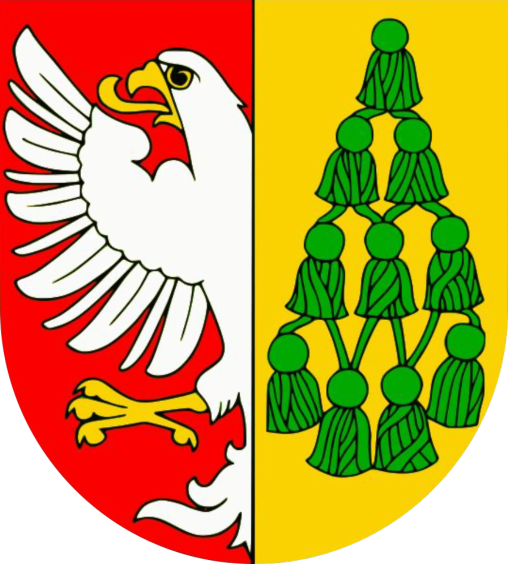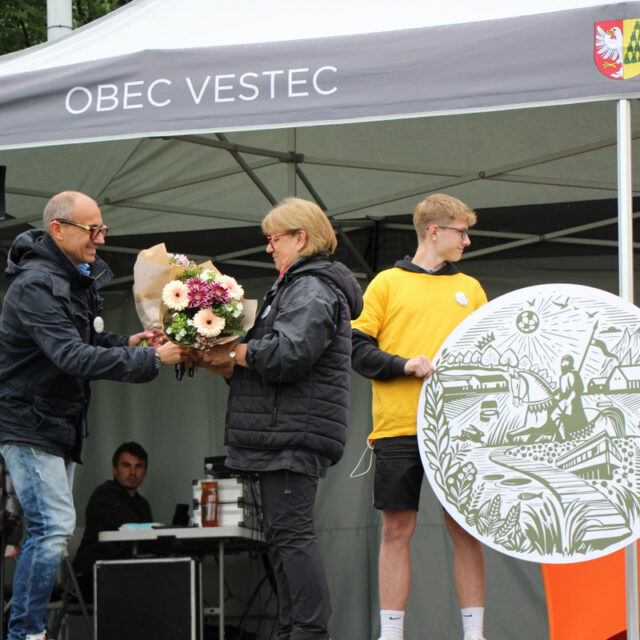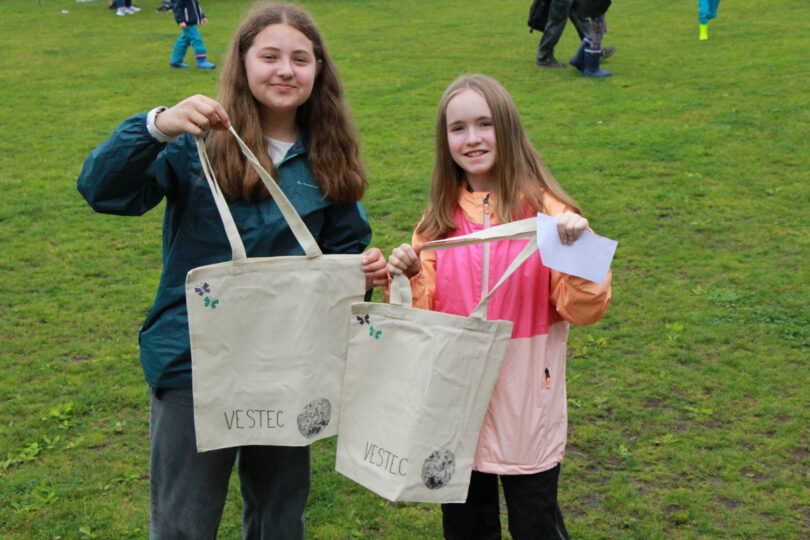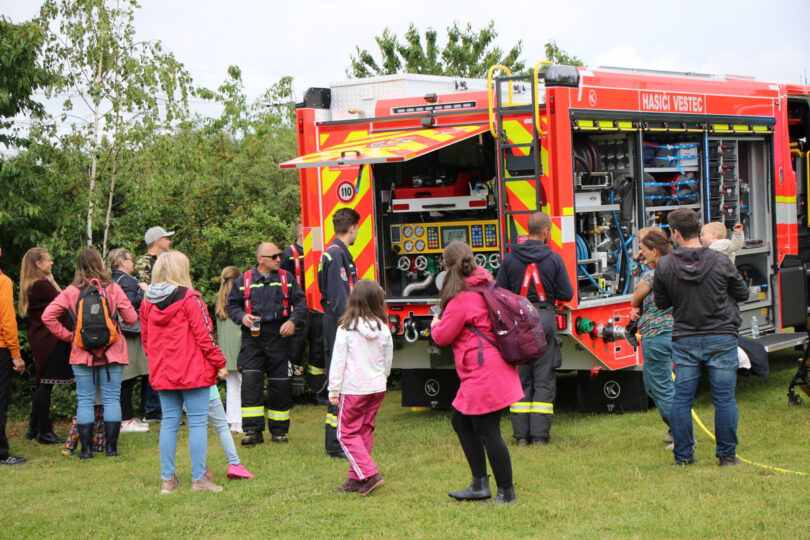Vestec seal
The new Vestec seal connects history with the present and symbolizes what makes Vestec unique.

How the seal was created
Our goal was to create a visual identity for the village that would be able to connect various cultural and social events. We were most impressed by the work of the team of graphic designer Michal Hořava and his colleague Ivana Stránská. They designed the new visual in the shape of a seal. Ivana Stránská was then the one who searched through the Vestec chronicles and outlined the first milestones that could appear in the future seal - for example, Jan of Hardeka as the first holder of Vestec or the historical burning of the village, which probably most of the inhabitants had not heard about yet. The Vestec pond, Prince Philip's Lime Alley, the municipal well and the symbol for agriculture also appeared in the very first draft. Further modifications simplified the rather complex engraving and added other elements from history and the present.
An interview with the authors of the seal can be read in Vestecky List - June 2024.
What you will find in the seal
The seal of Vestec hides many symbols and ingeniously combines the history with the present of the village. Can you discover them all?

- John of Hardeka, purgrave of Magdeburg - is the first traceable holder of the village of Vestec, which was referred to in contemporary sources as "villa Beska". He acquired it as a manor (i.e. a grant with the obligation of service) from Charles IV in 1360, together with the royal castle of Kostelec nad Sázavou (today Zbořený Kostelec) and the estate of 10 surrounding villages. The origin of the village itself, however, may be much older, as it was located near an important trade route from Prague to Vienna and Solnohrad. From the 15th century Vestec was under the administration of the Old Town of Prague, from 1715 the village was under the administration of the Prague Archbishopric. All of the aforementioned ownerships are also reflected in the coat of arms of Vestec - the eagle is derived from the coat of arms of Jan of Hardek, the green tassels are taken from the rank hat of the archbishop and the red and golden half tassels have the tinctures that the Old Town had at its disposal.
- Burning of the village - In 1508, Vestec (reported as Vesec) was burnt down by a group of brigands led by the knight Jiří Kopidlanský, who thus indirectly punished the royal city of Prague by burning down its suppliers. He was taking revenge for the execution of his brother, whom the Prague councillors had handed over to execution for a brutal murder in the Old Town Square, although they were not allowed to decide about a natural-born man. The same unfortunate fate also befell neighbouring Jesenice, Michle, Nusle or Vršovice. The first official Volunteer Fire Brigade (SDH) was established in Vestec as early as 1912. In addition to firefighting, the volunteer firefighters were important to the municipality, especially as a group organising various dance parties and carnival parades.
- Municipal well - is located on Vestecka Street and you may pass it daily. The original small well, paved with stones, was a non-drying source of water even in times of severe drought when water was lost elsewhere. It was a source of soft water for the laundresses and housewives from the estates who would come here with their carts and large containers to fetch it. In the early 1970s, the original well was reinforced with logs and is still functional today. Lots of water in the soil is quite typical for our village - many parts are still waterlogged today and many places have names that refer to water (e.g. the Pramenná bus stop or Nad Jezerem or V Mokřinách streets).
- Football in Vestec - has a really long tradition. The first organized group of football enthusiasts was formed in 1932 and before the municipality provided them with a space on the meadow by the pond, they first used the plaza behind the house with no. Instead of a clubhouse and changing rooms, the facilities of the U Klimešů restaurant served them for many years and they sometimes had difficulty putting together a complete eleven for competitive matches. During its history, the Viktoria Vestec sports club had to move temporarily from Vestec and was renamed Baník for a short time. Today, Viktoria Vestec is no longer just a football club, but also a netball, table tennis or majorette club, which together have around 400 members and have beautiful facilities at the sports ground by the pond.
- Vestecký pond - from 1700 it belonged together with the village to the Dolní Břežany estate, which was under the administration of the Prague archbishopric. At that time it was called "manor" and the Břežany estate kept fish here for its own use. However, as the local fish were caught for their own use to a greater extent than the lords liked, the manor had the pond drained and planted with oats in the 1880s. However, the locals needed the pond not only for the fish, but mainly for their livestock, so they asked the archbishop to buy the pond for the village. Today, the surroundings of Vestecký Pond have been transformed into a leisure area for the general public. The most famous feature that has made the whole of Vestec famous is the wooden footbridge on the pond created in 2010 and the viewing and resting piers that complemented it in 2014.
- Football in Vestec - has a really long tradition. The first organized group of football enthusiasts was formed in 1932 and before the municipality provided them with a space on the meadow by the pond, they first used the plaza behind the house with no. Instead of a clubhouse and changing rooms, the facilities of the U Klimešů restaurant served them for many years and they sometimes had difficulty putting together a complete eleven for competitive matches. During its history, the Viktoria Vestec sports club had to move temporarily from Vestec and was renamed Baník for a short time. Today, Viktoria Vestec is no longer just a football club, but also a netball, table tennis or majorette club, which together have around 400 members and have beautiful facilities at the sports ground by the pond.
- Football in Vestec - has a really long tradition. The first organized group of football enthusiasts was formed in 1932 and before the municipality provided them with a space on the meadow by the pond, they first used the plaza behind the house with no. Instead of a clubhouse and changing rooms, the facilities of the U Klimešů restaurant served them for many years and they sometimes had difficulty putting together a complete eleven for competitive matches. During its history, the Viktoria Vestec sports club had to move temporarily from Vestec and was renamed Baník for a short time. Today, Viktoria Vestec is no longer just a football club, but also a netball, table tennis or majorette club, which together have around 400 members and have beautiful facilities at the sports ground by the pond.
- Safina - this originally state-owned company has been operating in our village since 1953 and has been the most important employer for many residents of Vestec and the surrounding area. Its premises are located in the left part of the large premises near Vídeňská Street and are separated from the surrounding area by high concrete walls. Today, the company produces precious metal products for the electrical, chemical and automotive industries, as well as products for jewellers and jewellery makers.
- BIOCEV - abbreviation for the Biotechnology and Biomedical Centre of the Academy of Sciences and Charles University in Vestec, which has been operating in the village since June 2016. It is a cutting-edge scientific facility with international reach. Its results are directed towards applied research and the development of new treatments for serious health problems. It is part of the STAR region, which brings together research, technology and companies in the vicinity of Vestec, Zlatnice-Hodkovice and Dolní Břežany, creating an attractive region for investment. Vestec has thus become a major centre of science and research, attracting attention from all over the world.
- Agriculture and the Green Backbone - Agriculture has always been the traditional livelihood of the local population. Today, arable land occupies 40 % of the total area of the municipality. The fields in the entire cadastre of the municipality are privately owned, most of them are owned by Agru Jesenice, which has been farming them and growing agricultural crops for many years. However, the fields around the Vestecký Pond have been gradually grassed over in the last decade, creating the basis for the so-called Green Spine. The Green Backbone follows the Olšanský Brook and aims to ensure better water management and better conditions for the creation of natural habitats for plants and animals, and thus also contribute to increasing the attractiveness of these places for residents. It should offer even more nature just a step away from residential development. The large meadow below the nursery should be transformed into a meadow interspersed with smaller retention basins, paths and mature vegetation. A natural wetland with bird observation areas should be created in the area near the retention basin, towards Prague-Kunratice.
- Linden avenue with Prince Philip's crown - The avenue was planted in Vestec by the retention reservoir along the cycle path towards Kunratice in 2022 and is named Prince Philip's Alley. Prince Philip, Duke of Edinburgh, was the husband of Britain's Queen Elizabeth II, who was a lifelong supporter of young people and founded the Duke of Edinburgh's International Award (DofE) programme dedicated to supporting young people around the world. The avenue of 100 lime trees is intended to symbolically commemorate his 100th birthday. Following Prince Philip's death in 2022, the administration of the DofE programme was taken over by his youngest son Edward, who personally visited Vestec in 2023 and planted the last, 100th tree in the lime avenue. Around the centre of the avenue you will find a pleasant seating area under a gazebo, a public barbecue area and also a unique poetry machine which plays songs, lyrics and poems associated with Vestec or the British Royal Family.
This graphic describes all the elements hidden in the seal.

No other municipality has the form of a seal using engraving as its symbol and it will surely soon become a distinctive visual signature that everyone will associate with Vestec.
New visual of the municipality
The preparation of the new seal took the team of authors about five months and the output is not only this seal, but the entire visual manual and proposals for the use of the seal as a connecting element on printed materials, advertising items, but also on the furniture in the village. The seal is designed to work even when divided into quarters, where each quarter represents a different type of event according to the most prominent attribute in that section. And those who know the Vestec Seal and see parts of it in different settings, on different parts of the furnishings, will be able to connect the pieces into a whole. Soon you will be able to see it on new signposts or benches. But not as a striking contrasting logo, but rather as an unobtrusive engraving, a colour within a colour...
The first significant use of the Vestec seal motif was on returnable cups for our cultural events. Do you like it?































